Data extracted in April 2025.
Planned article update: October 2025.
Highlights
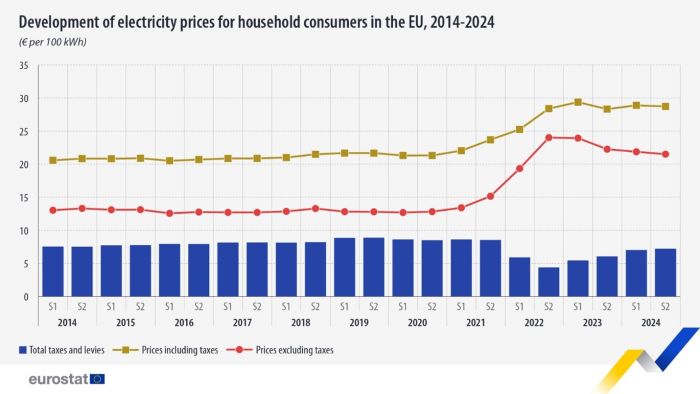
This article highlights the development of electricity prices both for household and non-household consumers within the European Union (EU). When available, it also includes price data from Iceland, Liechtenstein, Norway, Montenegro, North Macedonia, Albania, Serbia, Türkiye, Bosnia and Herzegovina, Kosovo*, Moldova, Georgia and Ukraine.
The price of energy in the EU depends on a range of different supply and demand conditions, including the geopolitical situation, the national energy mix, import diversification, network costs, environmental protection costs, severe weather conditions, or levels of excise and taxation. Note that the prices presented in this article include taxes, levies and VAT for household consumers, but exclude refundable taxes and levies for non-household consumers.
*This designation is without prejudice to positions on status, and is in line with UNSCR 1244/1999 and the ICJ Opinion on the Kosovo declaration of independence.
Electricity prices for household consumers
Highest electricity prices in Germany and Denmark
For household consumers in the EU (defined for the purpose of this article as medium-sized consumers with an annual consumption between 2 500 Kilowatt hours (KWh) and 5 000 KWh), electricity prices in the second half of 2024 were highest in Germany (€0.3943 per KWh), Denmark (€0.3763 per KWh), Ireland (€0.3699 per KWh) and Belgium (€0.3313 per KWh) - see Figure 1. The lowest prices were observed in Hungary (€0.1032 per KWh), Bulgaria (€0.1217 per KWh) and Malta (€0.1301 per KWh). For German household consumers, the per KWh cost was 37% above the EU average price, whereas households in Hungary, Bulgaria and Malta paid less than half the price of the EU average.
The EU average price in the second half of 2024 — a weighted average using the most recent (2023) consumption data for electricity by household consumers — was €0.2872 per KWh.
Figure 2 depicts the development of electricity prices for household consumers in the EU since the first half of 2008. The price without taxes, i.e. the energy, supply and network, was relatively stable between 2016 and 2020. After a sharp rise in both semesters of 2022, reaching a peak of €0.2401 per KWh in the second half of that year, the price excluding taxes slightly decreased to €0.2393 per KWh in the first half of 2023, followed by a further drop to €0.2226 per KWh in the second half. In 2024, it began to stabilize at levels above pre-crisis prices, figuring at €0.2151 per KWh, in the second half of the year.
Electricity price including taxes for household consumers consistently increased after 2021, except for a drop in the second half of 2023. In the first half of 2024, the price saw a modest 2% rise, compared with the second half of 2023, reaching €0.2889 per KWh and in the second half of 2024, it showed a marginal drop to €0.2872 per KWh. This was -2.2% lower than the price in the first half of 2023 (€0.2937 per KWh), which had marked the highest recorded level.
The percentage of taxes in the total price increased by almost 10 percentage points (pp) from 31.2% in the first half of 2008 to 41.0% in the second half of 2019. After this point, it substantially decreased until the second half of 2022 (15.5%), when taxes were the lowest in the entire period for which data are available. Moderate and stable tax increases were recorded in both semesters of 2023 and in both semesters of 2024, reaching 25.1% in the second half of the year. These figures reflect the impact of the governmental measures to mitigate EU household electricity costs in 2022 and the gradual reduction of those measures in 2023 and 2024. This reduction of consumer relief measures, reflected in Figure 2 as gradual increase of taxes, is the reason for the contrasting trends observed in both semesters of 2024. During this period, the price excluding taxes declined, while the price including taxes slightly raised.
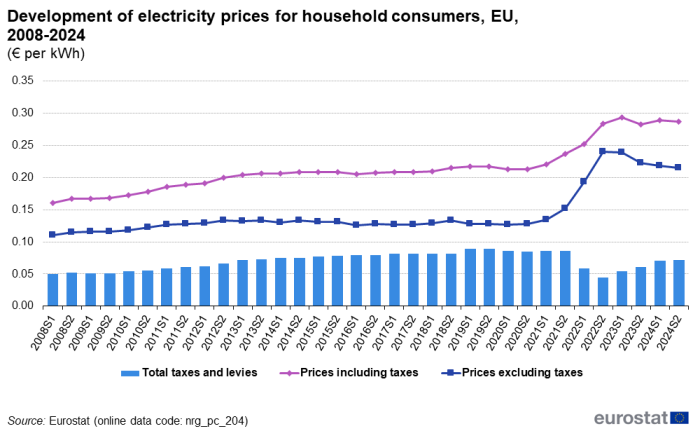
Source: Eurostat (nrg_pc_204)
Weight of taxes and levies differs greatly between EU countries
Figure 3 shows the proportion of taxes and levies in the overall electricity retail price for household consumers. In the EU, the share of taxes in the second half of 2024 was the lowest in Luxembourg, where the values were in fact negative (-49.2%). Negative taxes, reflecting the subsidies and allowances, were also observed in the Netherlands, Austria and Ireland. The relative share of taxes was highest in Denmark, making up 48.8% of the total price. The average share of total taxes and levies at EU level in the second half of 2024 was 25.1%, an increase of 3.7 pp when compared with the second half of 2023, and an increase of 0.8 pp when compared with the first half of 2024, mostly driven by reduction of subsidies and allowances. The VAT in the EU represented 14.4% of the total price. It ranged from 4.8% in Malta to 21.3% in Hungary.

Source: Eurostat (nrg_pc_204)
Largest increase in electricity prices in Portugal, Finland and France
Figure 4 shows the percentage change in electricity prices for household consumers including all taxes and VAT between the second half of 2024 and the second half of 2023. For comparison purposes, the national currencies were used. For energy prices, comparing year on year instead of semester on semester is most meaningful to avoid seasonal effects. However, these seasonal effects are less prominent in the recent semesters. Year on year, the total prices increased in 10 of the EU countries, while they decreased in 14 EU countries and remained almost unchanged in 3 EU countries. The largest increase was observed in Portugal (14.2%), followed by Finland (13.6%) and France (12.9%). Mainly network costs, as well as the reduction of subsidies and allowances drove the increase. Latvia (-17.8%), the Netherlands (-14.3%) and Belgium (-12.3%) were the 3 EU countries to record the largest decreases.
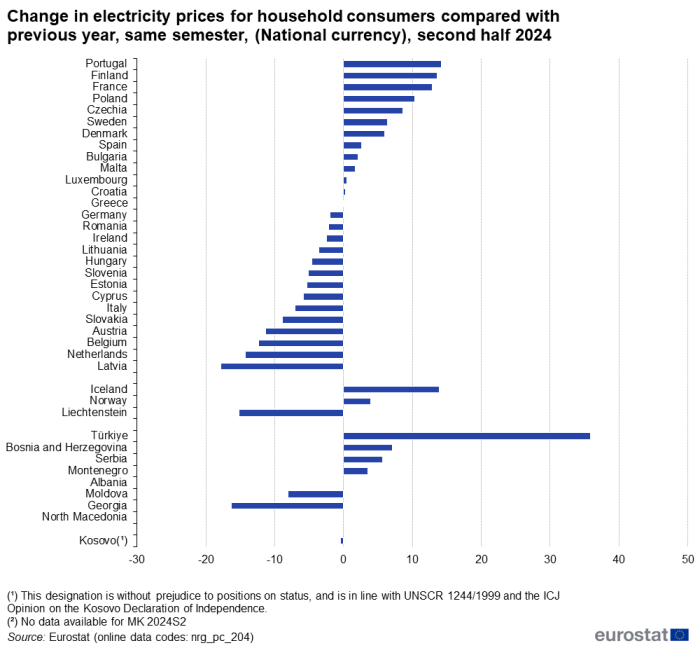
Source: Eurostat (nrg_pc_204)
Electricity prices in purchasing power standard
In Map 1, electricity prices for household consumers in the second half of 2024 are shown in purchasing power standard (PPS), grouping the available countries in 6 categories, with electricity price categories ranging from above 37 PPS per 100 KWh to below 17 PPS per 100 KWh. Electricity prices based on PPS were highest in Czechia (41.0) and Cyprus (35.7). The lowest electricity prices based on the purchasing power standard were observed in Malta (14.3) and Luxembourg (15.4).

(PPS per 100 KWh)
Source: Eurostat (nrg_pc_204)
Share of transmission and distribution costs for household electricity consumers
Figure 5 presents the share of transmission and distribution costs for household electricity consumers. Transmission and distribution costs are only reported once a year, at the end of the second semester. Distribution costs account for the largest share by far, when compared with the transmission costs. This is normal for all types of networks including the electricity system.
Transmission network is used for transmitting bulk amounts of energy over long distances. The distribution network is usually the part of the system where the consumers are connected. The distribution network is denser than the transmission network, therefore, its share in the costs is expected to be higher.
Countries with lower population density require a more extensive transmission network to meet their needs. Their costs are higher when compared with the countries with higher population density. Smaller, densely populated countries use mostly their own distribution network.
The latest available data for transmission and distribution costs are for the year 2024, in which, Luxembourg (100.0%), Slovakia (93.0%) and Finland (90.0%) had the highest shares of distribution costs. On the other hand, Lithuania(39.2%), Ireland (36.0%) and Germany (34.8%) had the highest shares of transmission costs.
Electricity prices for non-household consumers
Electricity prices highest in Cyprus and Ireland
Non-household consumers are defined for the purpose of this article as medium-sized consumers with an annual consumption between 500 MWh (Mega Watt hours) and 2 000 MWh. As depicted in Figure 6, electricity prices in the second half of 2024 were highest in Cyprus (€0.2578 per KWh) and Ireland (€0.2552 per KWh). The lowest prices were observed in Finland (€0.0767 per KWh) and Sweden (€0.0853 per KWh). The EU average price in the second half of 2024 was €0.1899 per KWh. The aggregates are weighted averages taking into consideration the average consumption in each band.
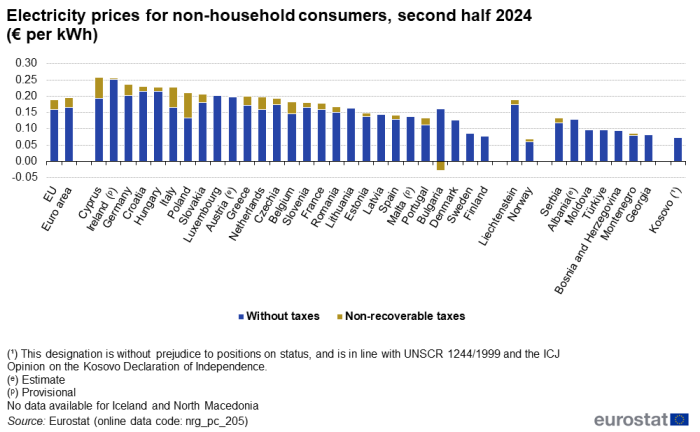
Source: Eurostat (nrg_pc_205)
Figure 7 shows the development of electricity prices for non-household consumers in the EU since the first half of 2008. The price without taxes, i.e. the energy, supply and network, underwent minor fluctuations until 2021. After this point in time, during the second half of 2021 and even more so, throughout both halves of 2022, the price registered significant increases, peaking at €0.1986 per KWh in the second half of 2022. Subsequently, in both halves of 2023 (€0.1936 per KWh in the first half and €0.1771 per KWh in the second) as well as the first half of 2024 (€0.1558 per KWh), the price recorded declines. In the second half of 2024, prices excluding taxes showed a marginal increase for the first time since the peak, reaching €0.1597 per KWh. The proportion of taxes rose by 21.0 pp, from 13.8% in the first half of 2008 to 34.8% in the first half of 2020, before declining. By the first half of 2024, the share of taxes had fallen to 16.6%, and further decreased to 15.9% in the second half, reflecting an increase from the lowest point of 5.6% recorded in the second half of 2022.
Looking at the non-household total price, i.e. including non-recoverable taxes, the increase persisted for an additional semester compared with the price excluding taxes and peaked at €0.2151 per KWh in the first half of 2023. In the second half of 2023, the price declined (€0.2008 per KWh), followed by a further drop in the first half of 2024 (€0.1867 per KWh). In the second half of 2024 the price showed a 1.7% increase, figuring at €0.1899 per KWh.
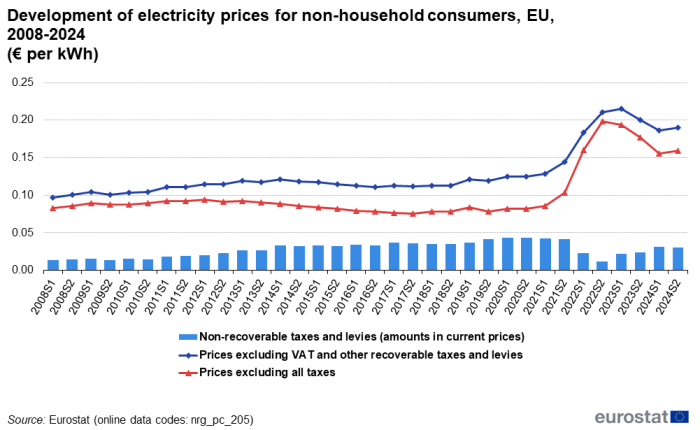
Source: Eurostat (nrg_pc_205)
Proportion of non-recoverable taxes and levies in electricity prices
Figure 8 presents the proportion of non-recoverable taxes and levies on the overall electricity price for non-household consumers. In the second half of 2024, the share of taxes was highest in Poland and Italy, where non-recoverable taxes and levies made up 36.9% and 27.0% of the total price, respectively. Bulgaria had negative taxes for the second half of 2024 (-21.4%). The share of taxes for the EU in the second half of 2024 stood at 15.9%, showing an increase when compared with the second half 2023 (11.8%), but a moderate decrease, compared with the first half of 2024 (16.6%).

Source: Eurostat (nrg_pc_205)
Development of electricity prices for non-household consumers
Figure 9 shows the change in electricity prices for non-household consumers including all non-recoverable taxes and levies from the second half of 2023 to the second half of 2024. For comparison purposes the national currencies were used. Increases were reported only in 6 Member States, with Portugal (14.7%), Czechia (11.8%) and Denmark (9.8%), showing the highest increases, while Austria (-18.8%), France (-16.3%) and Belgium (-16.1%) reported the biggest price drops.
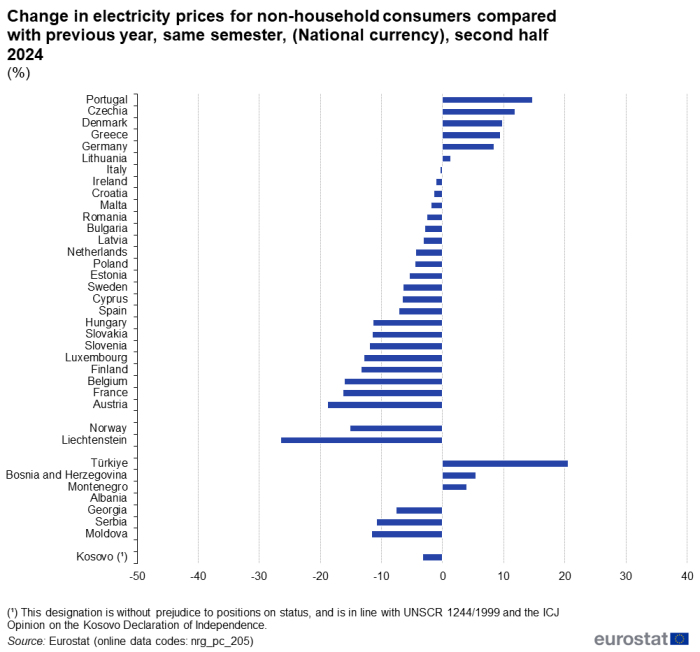
Source: Eurostat (nrg_pc_205)
Source data for tables and graphs
Data sources
Defining household consumers
Throughout this article, references to household consumers relate to the medium standard household consumption band with an annual electricity consumption between 2 500 KWh and 5 000 KWh. All figures are consumer retail prices and include taxes, levies and VAT. The full datasets for electricity prices for households consumers are available at:
- Electricity prices for household consumers - bi-annual data (from 2007 onwards) (nrg_pc_204)
- Electricity prices components for household consumers - annual data (nrg_pc_204_c)
and
Defining non-household consumers
Throughout this article, references to non-household consumers relate to the medium standard non-household consumption band with an annual consumption of electricity between 500 MWh and 2 000 MWh. In this article, prices correspond to the price of electricity production, its supply, the network costs and includes all non-recoverable taxes and levies. The full datasets for electricity prices for non-households consumers are available at:
- Electricity prices for non-household consumers - bi-annual data (from 2007 onwards) (nrg_pc_205)
- Electricity prices components for non-household consumers - annual data (nrg_pc_205_c)
and
Methodology
Prices in national currencies are converted into euro using the average exchange rate of the period for which the prices were reported.
Prices are always compared with the prices of the same semesters (i.e. year on year) in order to avoid seasonal effects.
In 2016, Regulation (EU) 2016/1952 entered into force. It defines the obligation for the collection and dissemination of electricity prices for household and non-household consumers. Until 2016, the domain of non-household consumers was defined as industrial consumers, but reporting authorities were allowed to include other non-household consumers. Regulation (EU) 2016/1952 changed the definition from industrial to non-household consumers to have a unique methodology for all reporting countries. Until January 2017, the reporting authorities provided their price data for the household sector on a voluntary basis.
Electricity tariffs or price schemes vary from one supplier to another. They may result from negotiated contracts, especially for large non-household consumers. For smaller consumers, they are generally set according to a number of characteristics including the amount of electricity consumed. Most tariffs also include some form of fixed charge. There is, therefore, no single price for electricity. In order to compare prices over time and between EU countries, this article shows information for consumption bands for household consumers and for non-household consumers. Electricity prices for household consumers are divided into 5 annual consumption bands and, for non-household consumers, into 7 different consumption bands.
The prices collected cover average prices over a period of 6 months (a half-year or semester) from January to June (first semester) and from July to December (second semester) of each year. Prices include the basic price of electricity, transmission and distribution charges, meter rental, and other services. Electricity prices for household consumers presented in this article include taxes, levies, non-tax levies, fees and value added tax (VAT) as this generally reflects the total price paid by household consumers. As non-household consumers are usually able to recover VAT and some other taxes, prices for non-household consumers are shown without VAT and other recoverable taxes/levies/fees. The unit for electricity prices is that of euro per kilowatt-hour (€ per KWh).
Allowances in the reference period 2024 Semester 2
- Belgium
With regard to household consumption of electricity and gas, in Belgium, the lower TVA rate of 6% introduced by the Government in 2023, remained at the same level for S1 2024.
- Czechia
- All price compensations were ended by 31 December 2023. There is no price compensation for the year 2024.
- Denmark
There are no subsidies affecting the prices in 2024. For previous semesters, there were measures in first semester 2023 the electricity tax (for households) were reduced to the lowest possible, lowering the final prices with about DKK 0.70 (plus VAT) per kWh comparing with the semester before and also after. This affected fully the households with low annual use (DA, DB, DC), while users in DB and DE already payed less taxes per KWh caused by expected use for heating. In 2022 there was a special compensation for high energy/heating prices, paid out as a lump sum. This mainly affected household users of natural gas. The compensation reduced prices with DKK 83 per GJ.
- Germany
Gas: The value-added tax (VAT) was temporarily reduced to 7 percent in October 2022 as a measure to relieve consumers. This temporary reduction on the supply of natural gas ended on March 31, 2024. Since then, the VAT rate has returned to 19 percent, for both household and non-household consumers.
- Ireland
Electricity: Ireland Household Prices: Due to the increases in energy prices from 2022, Ireland has introduced measures to alleviate the burden on final consumers. Domestic electricity customers, including pay as you go customers, have so far received €1500 worth of credits on their electricity cost, spread over their bills as follows: April/May 2022: €200, November/December 2022: €200, January/February 2023: €200, March/April 2023: €200, December 2023: €150, January 2024: €150, March 2024: €150, November/December 2024: €125, January/February 2025: €125. A further measure to tackle rising energy costs has been introduced in the way of a cut in VAT on gas and electricity bills from 13.5% to 9% from 1 May 2022. This VAT reduction has now been extended to October 2025. Ireland Non-Household Prices: The Temporary Business Energy Support Scheme (TBESS) was introduced in the second half of 2022 to support non-domestic customers with increases in their electricity or natural gas (energy) costs. The scheme was administered by Ireland Revenue and provided a cash payment to qualifying non-domestic customers. As it was not administered by electricity suppliers, TBESS rebates are not accounted for in the prices. The time limit for making a claim for the Temporary Business Energy Support Scheme (TBESS) expired on 30 September 2023.
Gas:
Ireland Household Prices: To tackle rising energy costs, VAT on gas and electricity bills has been cut from 13.5% to 9% from 1 May 2022. This VAT reduction has now been extended to October 2025. Ireland Non-Household Prices: The Temporary Business Energy Support Scheme (TBESS)[1] was introduced in the second half of 2022 to support non-domestic customers with increases in their electricity or natural gas (energy) costs. The scheme was administered by Ireland Revenue and provided a cash payment to qualifying non-domestic customers. As it was not administered by electricity suppliers, TBESS rebates are not accounted for in the prices. The time limit for making a claim for the Temporary Business Energy Support Scheme (TBESS) expired on 30 September 2023.
- Greece
Support measures regarding electricity 2024
i. For household customers there was a financial allowance,on the electricity bill, for those who used electricity for heating purposes during the period from January up to March. However, not all consumers were eligible, as certain conditions had to be met. Furthermore, for August, September and December specific measures were applied regarding consumers with non fixed, per kWh, price contract. ii. For non household customers support measures were in force only for the first semester 2024. A specific category of energy-intensive non household consumers, who met certain criteria, received a compensation. However, although it concerned only the first semester it also affected the prices of the second one as it was paid retrospectively.
- Natural gas 2024:
- In the case of the consumption of natural gas, there is no price compensation for the year 2024.
- France
- Gas
Allowances: period 2024 S1 and S2 The standard rate of excise duty on gas will rise from €8.37/MWh to €16.37/MWh on January 1, 2024. Reduced rates are unchanged. In 2024, collective housing will continue to benefit from bill payment assistance to cope with rising gas prices. The French government will cover 75% of the difference between the price actually paid and the reference price of €72.8/MWh, for contracts signed before June 30, 2023.
Electricity:
Allowances: period 2024 S1 and S2
- - Most of the measures taken to reduce energy costs in 2022 and 2023 are no longer in force.
- - Electricity excise duty for households has been raised from €1/MWh to €21/MWh, and €20.5/MWh for businesses with a contract power of less than 250 kVA, on February 1, 2024.
- - The rate freeze on regulated electricity sales tariffs, eligible for household and small businesses, has been lifted.
- - However, measures to limit the cost of electricity to €280/MWh for very small businesses remain in force in 2024.
- - Small and medium-sized businesses continue to benefit from the electricity buffer, which covers up to 75% of the bill when the price exceeds €250/MWh, up to a limit of €2.25 million in cumulative aid over 2023 and 2024.
- - Medium-sized energy-intensive companies benefit from a targeted aid window that covers 75% of their bill above €300/MWh.
- Croatia
- Gas
VAT remains at 5% Decision on subsidizing part of the final price of gas supply:
- - Support for households - from April 1 to September 30, 2024 subsidies for households were not accounted because the purchase price of gas was lower than 0,0277 EUR/kWh, which is prescribed by the Government Decision as the lowest amount of the purchase price up to which the final price is not subsidized. In the period from October 1 to December 31, 2024 subsidies for households amounted 0,0090 EUR/kWh in average, according to the Government Decision on subsidizing part of the final price of gas supply for households;
- - Support for non-households, annual gas consumption of up to 10 GWh - after March 31, 2024 there were no more subsidies of the final price for non-households.
Electricity:
In September 2024, the Government of the Republic of Croatia has adopted Regulation on amendments to the Regulation on eliminating disturbances on the domestic energy market which extended the application of special and temporary measures for electricity trade, for the period from October 1, 2024 to March 31, 2025. Regulation prescribes the price cap on electricity producers price, regulated prices for households and non-households, mitigating the rise in electricity prices, limitation of the increase in fees for electricity. Additionally, social benefits for citizens at risk of energy poverty, support for pensioners with low pensions.
- Spain
The Government of Spain has maintained the measures adopted during 2021 and reinforced them during 2022. The idea is to continue cushioning the impact of electricity prices on final consumers. These measures have focused on the "taxes, fees and charges" component, such as applying reduced rates to both VAT and the Special Electricity Tax, as well applying a new reduction in electricity charges applicable during 2023, comparing them with those of the previous year.
- Cyprus
The only supportive measure for 2024 S1 in Cyprus both for households and part of commerce is "A percentage subsidy imposed by the Ministry of Finance on specific categories of consumers based on scaled consumption as from September 2022 to October 2024".
- Latvia
Electricity prices:
In the 1st and 2nd half of 2024, households have discounts on the electricity distribution tariff, but non-households do not have discounts on the electricity distribution tariff. Since 1P 2024, new distribution and transmission tariffs have come into effect for electricity in Latvia. Natural gas prices:
In the 1st half of 2024, there is no discount on natural gas prices for households and non-households. Since the 1st half of 2024, new distribution tariffs have come into effect for natural gas.
- Lithuania
- Electricity
The State Energy Regulatory Council has set a zero price for public interest services (VIPS) for 2024. There are no longer any subsidies or allowances for the price of electricity in Lithuania.
- Poland
Electricity:
As regards electricity prices in Poland, the support system from 2023 was extended, by the Act, for the first semester of 2024. Measures for Gas: For certain groups of eligible customers, the maximum price for gaseous fuel shall apply. This applies mainly households and the majority of public utilities (education, health care, social assistance and many others). The net fuel price (level 1 without energy's supply) for such customers is a maximum of 55.602(7) PLN/GJ. The maximum price of gas fuel for the indicated groups is to be valid until 30 June 2024.
- Portugal
Support Measures for Electricity and Natural Gas in Portugal in 2024:
- With the aim of protecting consumers from the effects of energy market volatility and ensuring fairer access to energy, the Portuguese Government has implemented and extended several measures in the electricity and natural gas sectors:
- 1. Extension of Regulated Tariffs:
- The Government has extended the validity of regulated electricity and natural gas tariffs until 31 December 2025. This measure aims to protect household consumers from sharp price fluctuations.
- 2. Social Electricity Tariff:
- The social electricity tariff remains in force, aimed at economically vulnerable consumers. This support provides a reduction applied on network access tariffs.
- 3. Reduction of VAT Rate on Electricity:
- The reduced VAT rate on electricity has been maintained and extended to cover a larger number of families, as established by Law No. 38/2024, published in August 2024.
- The 6% reduced rate is now applied to electricity consumption of up to 200 kWh per month for contracts with a contracted power of up to 6.9 kVA.
- For large families (households with five or more members), the limit is increased to 300 kWh per month.
- Consumption above these thresholds remains subject to the standard VAT rate of 23%.
- 4. Social Natural Gas Tariff:
- The social natural gas tariff has been maintained for economically vulnerable consumers on low-pressure networks, applied to network access tariffs.
- 5. Return to the Regulated Natural Gas Market:
- Consumers still have the option to return to the regulated natural gas market, where tariffs are set by the National Regulator (ERSE).
- 6. Reduction of Electricity Network Access Tariffs:
- The reduction in electricity network access tariffs has also been maintained, helping to contain the final prices paid by consumers.
- Romania
- According to the national law requirements (Government Emergency Ordinance no. 27/2022 regarding the measures applicable to final customers on the electricity and natural gas market in the period April 1, 2022-March 31, 2023 with subsequent amendments and additions, still in force during S2 2024), the electricity and gas prices (tariffs/taxes/VAT included - level 3) charged to final clients are capped, therefore, the final invoiced price/kWh (including VAT) for electricity cannot exceed one of the following values: 0.68 lei/kWh, 0.80 lei/kWh or 1.3 lei/kWh (VAT included), depending on type of client (household/non-household) and on consumption level.
- For natural gas, the capped values of the final invoiced price/kWh (including VAT) are 0.31 lei/kWh - for household clients, respectively 0.37 lei/kWh - for non-household clients. These values are not dependent on consumption levels.
- Slovenia
- 1. Electricity prices - measures
- One of the first measures that is in place from February 2022 is the amended Regulation on determining the amount of excise duty for electricity reduced the excise duty for final consumers of electricity for 50 %:
- - with an annual consumption of 0 to 10,000 MWh from EUR 3.05 per MWh to EUR 1.525 per MWh,
- - with an annual consumption above 10,000 MWh from EUR 1.800 per MWh to EUR 0.900 per MWh.
- With a government regulation the maximum permitted tariff items for the price of electricity for household customers and for the supply of electricity in common areas of multi-apartment buildings and mixed multi-apartment-commercial buildings, without VAT, amounted to:
- - Higher tariff (VT): 0.11800 EUR/kWh
- - Lower tariff (NT): 0.08200 EUR/kWh
- - Uniform tariff (ET): 0.09800 EUR/kWh
- from 1 January 2024 and 31 October 2024 and
- - Higher tariff (VT): 0.08400 EUR/kWh
- - Lower tariff (NT): 0.07000 EUR/kWh
- - Uniform tariff (ET): 0.07700 EUR/kWh
- from 1 November 2024 onwards (until 28 February 2025).
- From 1 January 2024 and 31 October 2024 the electricity prices were regulated for 90% of the consumed electricity, while from 1 November 2024 onwards, the prices were regulated for 100% of the electricity consumption (i.e. total).
- Regulation on the method of determining and calculating contributions for providing support for the production of electricity in cogeneration with high efficiency and from renewable energy sources was amended, which resulted in omitted contribution of RES+CHP for electricity consumers for households in 2024. RES+CHP contribution is reported under “environmental taxes” in Eurostat’s tables for electricity prices.
- All other measures (i.e. subsidies for reducing electricity prices for industry in 2023) were discontinued on 1 January 2024.
- Detailed explanations on all measures (electricity prices) in place for the period from 2022 onwards are available on Energy portal (only in Slovene): https://www.energetika-portal.si/podrocja/energetika/ukrepi-za-omilitev-draginje-na-podrocju-energetike/elektricna-energija/
- Finland
- Household electricity:
- The Finnish government took several measures about energy cost compensations from 1 November 2022 to 30 April 2023. No more measures are taken beyond this period.
- Non-household electricity:
- Excise duty refunds to energy-intensive companies are paid retroactively upon refund application. These refunds are not included in electricity costs.
- These measures below were solely for household customers not non-household customers. Thus these should be removed from the non-household chapter "Allowances in the reference period 2023 Semester 1".
- "The Finnish government has taken several measures about energy cost compensations. The time period affected is from 1 November 2022 to 30 April 2023. No more measures are planned beyond this period. Thus, the effect on electricity prices limit on periods S2/2022 and S1/2023. S2/2022 is final. S1/2023 includes the VAT reduction and retroactive electricity bill compensation (1 and 2), but not the compensation reducing taxation (3) or compensation paid as electricity cost support (4). These data is only available after taxation for 2023 is final.
- (1) Value added tax of the electricity was reduced from 24% to 10% from 1 December 2022 until 30 April 2023.
- (2) Retroactive electricity bill compensation if the VAT-inclusive electricity price in household's electricity contract exceeded 10 cents per kilowatt-hour or if the electricity contract was based on spot prices (so-called market price) in November and December 2022 and/or January 2023. The compensation for electricity costs was 50% of the VAT-inclusive price of the electricity bill. The compensation was not granted to the distribution rate or electricity tax. The compensation couldn't exceed €700 per month. The amount of the compensation was calculated based on the part of your electricity bill that exceeded the threshold of €90/month. The compensation was paid in 2 instalments. The amount of the instalments was calculated in 2 different ways: The amount of the first instalment was calculated based on your electricity bills for November and December. The amount of the second instalment was calculated based on your electricity bill for January 2023 and is multiplied by two. Additional measures took effect from 1 January 2023 until 30 April 2023.
- (3) The compensation of the high electricity bills are part of the existing system of tax credit for household expenses. Electricity bill exceeding €2 000 until €6 000 during from 1 January 2022 to 30 April 2022 will be compensated by 60% and reduces the amount of tax the customer has to pay.
- (4) If no taxable income the compensation is made in the form of the electricity cost support. The 60% compensation will be paid by the Social Insurance Institution of Finland if the electricity bill will exceed €400 per month but not €1 500 per month from 1 January 2022 to 30 April 2022. Natural gas prices are not compensated by any means."
- "The Finnish government has taken several measures about energy cost compensations. The time period affected is from 1 November 2022 to 30 April 2023. No more measures are planned beyond this period. Thus, the effect on electricity prices limit on periods S2/2022 and S1/2023. S2/2022 is final. S1/2023 includes the VAT reduction and retroactive electricity bill compensation (1 and 2), but not the compensation reducing taxation (3) or compensation paid as electricity cost support (4). These data is only available after taxation for 2023 is final.
- Natural gas non-households:
- Excise duty refunds to energy-intensive companies are paid retroactively upon refund application. These refunds are not included in natural gas costs.
- Sweden
- Following the compensation provided during 2021 and 2022, there were no support measures in 2023, nor in 2024 for gas or electricity regarding households.
Context
The price and reliability of energy supplies, electricity in particular, are key elements in a country's energy supply strategy. Electricity prices are of particular importance for international competitiveness, as electricity usually represents a significant proportion of total energy costs for industrial and service-providing businesses. Contrary to the price of fossil fuels, which are usually traded on global markets with relatively uniform prices, electricity prices vary widely among EU Member States. The price of primary fuels and, more recently, the cost of carbon dioxide (CO2) emission certificates influence, to some degree, the price of electricity.
Communication from the Commission to the European Parliament, the Council, the European Economic and Social Committee and the Committee of the Regions, Energy Emergency - preparing, purchasing and protecting the EU together, COM2022(553) final, coordinates solidarity efforts, secures the energy supply, stabilises price levels and support households and companies facing high energy prices.
Communication from the Commission to the European Parliament, the Council, the European Economic and Social Committee and the Committee of the Regions, REPowerEU: Joint European Action for more affordable, secure and sustainable energy, COM2022(108) final, Commission to propose measures to coordinate solidarity efforts, secure the energy supply, stabilise price levels and support households and companies facing high energy prices.
In 2019, the European Commission presented the Clean energy for all Europeans package. The Commission completed a comprehensive update of its energy policy framework to facilitate the transition away from fossil fuels towards cleaner energy and to deliver on the EU's Paris Agreement commitments for reducing greenhouse gas emissions.
The Fit for 55 legislative proposals cover a wide range of policy areas including climate, energy, transport and taxation, setting out the ways in which the Commission will reach its updated 2030 target in real terms.
Regulation (EU) No 2016/1952 tackles data weaknesses led to the recommendation to improve the detail, transparency and consistency of energy price data collection. An energy prices and costs report would be prepared every 2 years. The European Commission thus published such a report also in 2016 and 2018.
The Seventh report on the state of the energy union was published on 18 October 2022. The 2022 report is the third report since the adoption of the European Green Deal and the first after the adoption of the REPowerEU plan. It highlights the challenges that the energy sector has faced in the past 12 months and the progress made in addressing both shorter-term issues and Europe's long-term climate goals. In particular, the report takes stock of the EU's energy policy response to the current energy crisis, exacerbated by Russia's war in Ukraine.
Increased transparency for gas and electricity prices should help promote fair competition, by encouraging consumers to choose between different energy sources (oil, coal, natural gas and renewable energy sources) and different suppliers. Energy price transparency is more effective when publishing and broadcasting as widely as possible prices and pricing systems.
Explore further
Other articles
Database
- Energy statistics - prices of natural gas and electricity (nrg_price)
- Energy statistics - natural gas and electricity prices (from 2007 onwards) (nrg_pc)
- Energy statistics - natural gas and electricity prices (until 2007) (nrg_pc_h)
Thematic section
Selected datasets
- Energy statistics - main indicators (t_nrg_indic)
- Electricity prices by type of user (ten00117)
External links
- Eurelectric
- Europe's Energy Portal
- European Commission — Energy
- Weekly oil bulletin (weekly pump prices)
- State of the energy union reports (State of the energy union reports)


